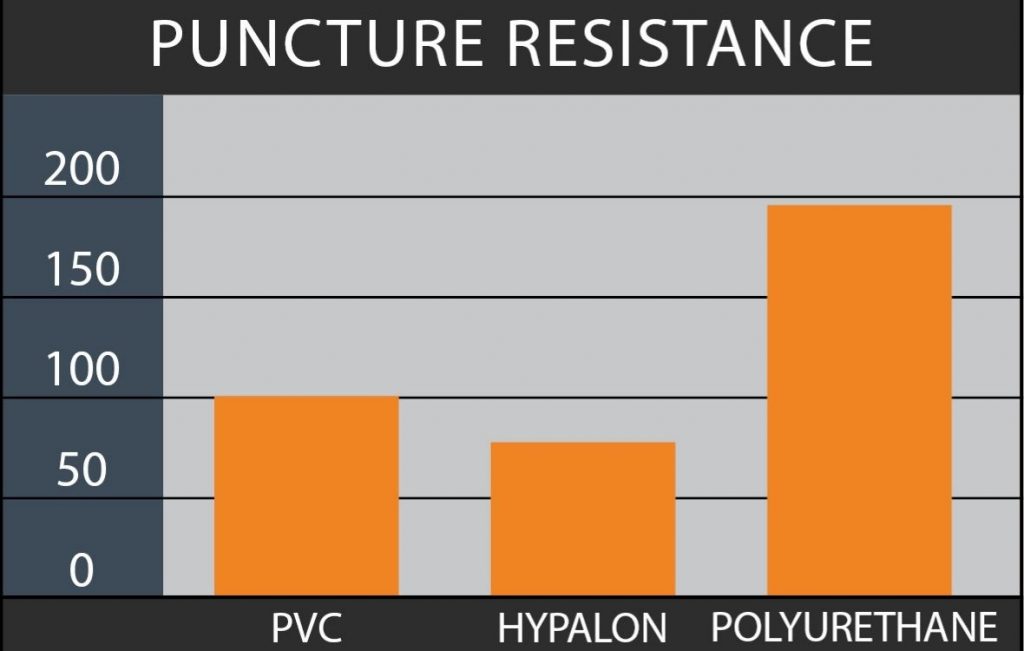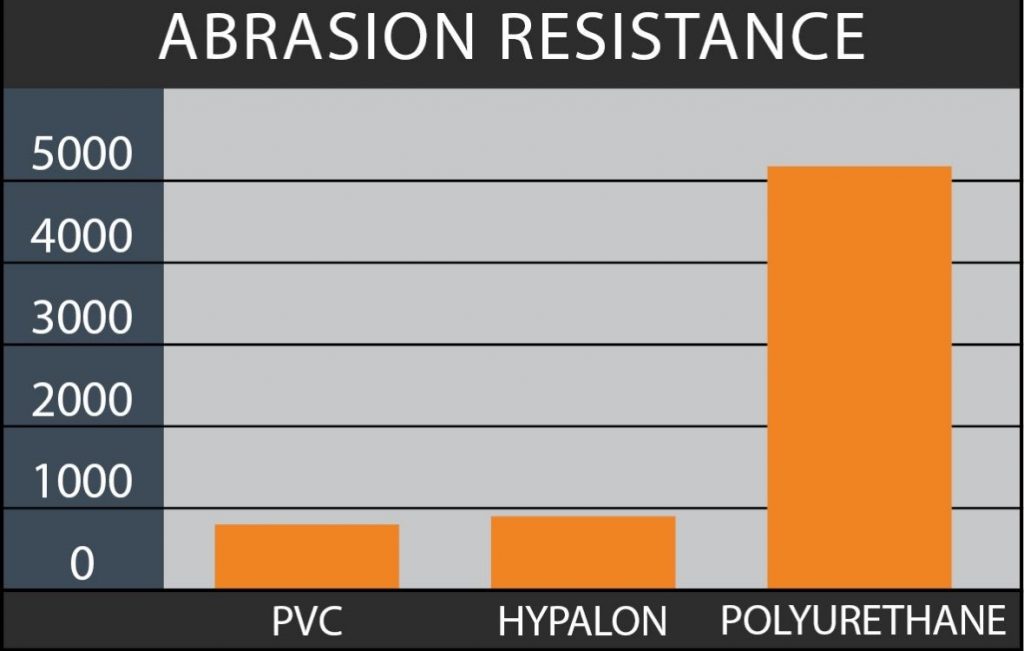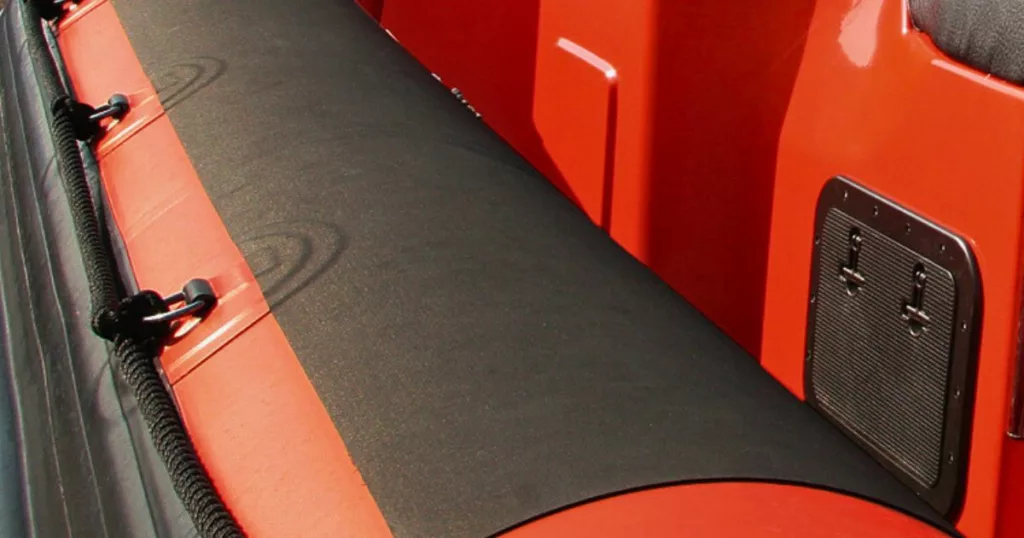One of the most important choices when choosing a RIB is the quality of the pontoon
The choice of material (fabric) in the production of the inflatable pontoon or tube and the techniques used in the production are vital for the boats quality and thus lifetime.
Boat fabrics used in the production of pontoons divides into 3 different categories: Polyvinyl Chloride (PVC) fabrics, Hypalon® fabrics or Polyurethane (PU) fabrics.
All 3 boat fabrics are made by a coating polymer (PVC, Hypalon or PU) together with a supporting fabric; polyamid (Nylon) or polyester. All boat fabrics can be found with both types.
In the production of the final fabric the polymer is added to the supporting fabric either by extrusion or by a coated hot roller. When adding the polymer with a coated hot roller the tear strength of the fabrics is considerably higher than that of fabrics made by extrusion.
Tornado Boats merely uses Polyurethane boat fabric made with a coated roller system.
Polyvinyl Chloride – PVC fabrics
Polyvinyl chloride, commonly abbreviated PVC, is a widely used thermoplastic polymer. PVC can be made softer and more flexible by the addition of plasticizers, the most widely used being phthalates. In this form, it is used in clothing and upholstery, and to make flexible hoses, tubing and of cause pontoons.
The plasticizer in PVC has the great disadvantage that it in time (and especially when exposed to UV-radiation) decomposes and leaves the pontoon fabric hard, crisp, and mechanically much weakened. Stories of pontoons that ‘rotten in the sun’ are stories of old PVC pontoons exposed to sun.
Fabrics made by PVC are hard to joint, you can only use a single cure adhesive, which is PU ester. Some manufacturers use high mechanical pressure, high frequency welding or electronically welding, which makes mass production of boats possible in a large scale with machinery and inexperienced labour.
PVC fabrics are produced in a larger palette of colors than fabrics made of Hypalon® and Polyurethane. PVC is considered the poorest material for pontoon production and is mainly used in cheap mass-produced boats.
Facts:
- A cheaper material than Hypalon® and Polyurethane has a short lifetime when exposed to sunlight (UV).
- Contains chlorine
- The strength and the ability to resist tear and wear is radically poorer than that of Hypalon® or Polyurethane.
- The production of PVC fabric is easier than when using both Hypalon® or Polyurethane.
- PVC is marketed under various names such as Strongan® and Duotex®
The following RIB manufacturers that use PVC:
ARIMAR, BOMBARD, BRIG¹, COMPASS II, EUROVINYL, EXCEL, HONDA, LODESTAR, MAXXON, METZLER, NARWHAL, OMC EXPRESS, PLASTIMO, QUICKSILVER, RIBEYE, SERIE, SEVYLOR, SUZUMAR, TOHATSU, TYPHOON, VALIANT², WAVELINE, YAM, ZED, ZOOM, ZODIAC³.
¹: Certain models can be delivered in Hypalon®.
²: Certain models can be delivered in Polyurethane.
³: Certain military models can be delivered in Hypalon®.
Hypalon®
Hypalon is a trademark for chlorosulfonated polyethylene (CSPE) synthetic rubber (CSM) noted for its resistance to chemicals, temperature extremes, and ultraviolet light.
Along with PVC, it is one of the most common materials used to make inflatable boats. Hypalon has become the common name for all kinds of CSM.
Hypalon® has demonstrated long life in harsh environments and is known for its air tightness and resistance towards different chemicals among others oil pollution.
Hypalon® fabrics is made of layers of polyester or polyamide and supplied with an internal layer of neoprene. Hypalon® has throughout the years proven to be a reliable and solid material for RIB pontoons.
Hypalon® is considered the second-best pontoon material. However, it is used by many manufacturers as it is technically easier to produce boats with Hypalon® fabric than Polyurethane fabric.
Facts:
- Hypalon shows a good resistance when exposed to sunlight (UV) and chemicals.
- Has a porous surface and a tendency of getting scratched, dirty and dull.
- When used in production the Hypalon fabric is not as technically demanding a material as Polyurethane.
- The fabric is more expensive compared to PVC.
- Contains chlorine.
- Hypalon is considered the second-best material in manufacturing pontoons.
The following RIB manufacturers use Hypalon®:
AB, ACHILLES, AQUAFLYTE, AVON, BALLISTIC, BEAUFORT, BRIG¹, BWM, CALAGARI, CAMPARI, CARIBE, CHINOOK, COMPASS, DELTA, DOMINO, EUROCRAFT, FLATACRAFT, GOMMONAUTICA, GORDON, HENSHAWS, HUMBER, JOKER, LOMAC, METZLER, ML LIFEGUARD, NOVAJOLLY, NOVAMARINE, NOVURANIA, OSPREY, PICTON, PRO-SAFE, RED BAY, REVENGER, RIBCRAFT, RIBTEC, RIB-X, RING, ROBCRAFT, RUPERT, SCANNER, SCORPION, SELVA, SEMPRIT, STINGHER, TINKER, VSR, YAM RIBS, ZODIAC².
¹: Brig normally use PVC, but certain models can against a surplus be delivered in Hypalon®.
²: Zodiac normally use PVC (Strongan®), but in military boats and in some professional boats Hypalon® is used.
Polyurethane
Polyurethane, commonly abbreviated PU. Polyurethanes are in the class of compounds called reaction polymers, which include epoxies, unsaturated polyesters, and phenolics.
100% Polyurethane material offers four times the abrasion resistance and greater tear or tensile strength compared to Hypalon® and much stronger than PVC.
Polyurethane fabrics have excellent welding properties. Both hot air/pressure rotary Welders and Radio Frequency Welders can be used to join the material together in a molten state, thereby creating an incredibly strong bond.
The combination of the elastomeric properties of Urethane and the resiliency properties of nylon allows the material to repeatedly stretch and still recover to show its original properties.
Polyurethane was originally manufactured in the early 70’s as fuel cell bladders for helicopter fuel for military use and has proved to be the ideal material for boat pontoons.
Facts:
- Polyurethane has an incredibly long lifetime.
- Resist mechanically wear and tear very well.
- The latest polyurethane fabrics produced by Chiorino shows an excellent resistance when exposed to sunlight (UV) and chemicals – even better than Hypalon®.
- The polyurethane coated fabric used by Tornado is SOLAS approved.
- Polyurethane is the strongest air-holding material available.
- Easy to repair.
- Polyurethane is less damaging to the environment
- Contains NO chlorine
- Demanding to use in production.YU
- Polyurethane is the best material for pontoons and is recommended for professional boats.
The following RIB manufacturers use Polyurethane:
TORNADO¹, VALIANT², SAFEBOAT, WING, TP MARINE, AQUATX and ZODIAC³
¹: Tornado uses only Polyurethane manufactured by Chiorino.
²: Marketed under the name Akron-TPE®.
³: Has in 2007 started manufacturing certain boats over 6 meter in Polyurethane, under the name Sharc® Duotex®.
Test of the abrasion and puncture resistance of the materials
Test of PVC, Hypalon® and Polyurethane regarding the abrasion and puncture resistance shows that Polyurethane is superior to both.


In 1993 the U.S. Navel Surface Warfare Center did a study on polyurethane and the advantages of using it for Rigid Inflatable boats.
The Technical Memorandum concludes:
“The data shows that the Urethane coated fabric is considerably stronger than the Hypalon® coated fabric.”
“…Polyurethane is more correctly defined as an elastomer, meaning, it can be repeatedly
stretched and still recover to show its original properties – a significant benefit for RIB tubes that
are often subjected to major stresses during wave impact.”
And it recommends:
“Urethane coated fabrics should be adopted as a replacement for Hypalon® coated fabrics in tube
construction on U.S. Navy RIBs.”
Another study, also by the U.S. Naval Surface Warfare Center, confirmed those results in 2001 and further stated that: “Tubes constructed of polyurethane coated fabric exhibit better key physical properties than tubes constructed of Hypalon coated fabric (…), better tensile strength, tearing strength, puncture resistance, coating adhesion, and abrasion resistance.”
Click here for more information on the subject.
Author: Lars Hjorth
Read PDf-version